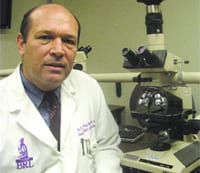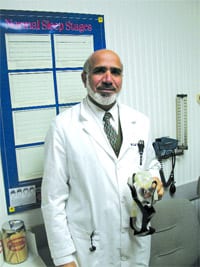Pathologist Loves the Scope of His Work
Dr. Richard Friedberg describes the field of pathology, or simply “path,” as those in this specialty call it, as “the interface of science and medicine.”
That was one of many phrases he put to use during a wide-ranging interview with The Healthcare News about this often-misunderstood — many people believe autopsies are the main focus; they’re not — yet all-important aspect of the health care system. “We’re the people with the answers,” he said at another juncture of the conversation as he talked about those who ultimately choose this specialty. “We’re the physician’s physician,” he said at another.
With all this terminology and much more, Friedberg, chairman of the Department of Pathology at Baystate Health and medical director of Baystate Reference Laboratories, drove home the point that, while pathologists don’t often see the patients for whom they’re conducting tests and formalizing diagnoses, they play a pivotal role in the care provided to them, which makes this field rewarding in ways much different than those experienced by the surgeon or the primary care physician.
“About once a day, we see a new breast cancer,” said Friedberg, referring to his team of 20 pathologists and a handful of residents. “That’s 300 or 400 a year; that’s a lot, and if you’re one of those women, that’s going to change your life.
“We know that every specimen that comes through here is someone’s mother, father, sister, brother, aunt, or uncle,” he continued. “And whatever answer we give — ‘it’s benign,’ ‘it’s malignant,’ whatever descriptive term we use — is going to change someone’s life. So even though they may not know us by name, and most people don’t know who their pathologist is, we know we’re having a pretty significant impact on their lives. Sometimes it’s good news, sometimes it’s bad news, sometimes it’s news that says, ‘this is treatable.’”
Using television shows like House and CSI Miami to make his point, Friedberg said the view the public often gets of pathology work is not exactly accurate. Indeed, the work is far less glamorous, and most of the answers don’t come nearly as quickly or easily as Hollywood makes it appear.
“On CSI, they have fancy tools, they have the answers in 15 minutes, they’re all good-looking and physically fit,” he noted. “The reality is much different, but this is where the science hits the patient.”
For this, the latest installment of its Today’s Physician series, The Healthcare News talked with Friedberg about pathology, where technology is taking it, and why he and others love the work they do behind the scenes.
Down to a Science
Friedberg calls it “the octopus.”
That’s his nickname for the giant, 14-headed microscope that fills nearly half of one of the rooms in Baystate’s Pathology Department. The instrument allows large numbers of people (more than 14, actually, because the image being examined can be projected onto a large video screen) to look at the same specimen at once.
The octopus is perhaps the most extreme example of how the pathology unit puts multiple minds and sets of eyes to work on a problem, said Friedberg, noting that each specialist’s microscope has two arms to it. And while he gave a quick tour of his department, Friedberg stopped at several offices where there were two people peering at a slide.
Such sharing of microscopes — and opinions — is a big part of pathology and Baystate’s team approach to it, he continued, adding that the “people with the answers,” as he called them, have a responsibility to come up with the right answer. Or, summing it up another way, he told The Healthcare News, “if the diagnosis is wrong, then nothing else matters.”
Getting things right has been at the heart of Friedberg’s job descriptions during a 22-year career in pathology. He’s taken a rather circuitous route to his stations at Baystate, one that started in Southern Rhodesia, now Zimbabwe, where he was born. Friedberg said his father was a cardiologist, and from an early age, he wanted to follow in his dad’s footsteps.
The family emigrated to the U.S. in 1964, settling in Baltimore before relocating to Milwaukee for many years. After doing undergraduate work at Stanford and then doing research work in England, he spent six and a half years at Duke University earning what’s known as an M.D./Ph.D., with his work in the latter focused on the “biochemistry of blood clotting.”
After spending nearly a decade as associate director of Transfusion Medicine Services at University Hospital on the campus of the University of Alabama Birmingham, Friedberg came to Baystate in 2001, and now has multiple titles on his business card, including chairman of the Pathology Department.
“It was because of this interest in science, biochemistry, and medicine that I ended up in path,” he said. “When you’re fascinated by the science that underlies the whole thing, pathology is a great world to come into.”
But while he was always drawn to medicine and especially science, Friedberg has also been interested in the arts, something he said he took from his mother’s side of the family.
“Growing up in Wisconsin, I actually spent a lot of time on stage at theater camps,” he explained, noting that his children now attend those same camps. “I’ve been in every musical imaginable, even though I can’t sing.
“What that teaches you is how to get in front of a room full of people, develop a stage presence, and not have that fear of public speaking, which is probably the most common fear,” he continued, adding that he’s put this talent to good use doing countless speaking engagements, during which he’s talked before audiences of up to several thousand people.
For example, he’s one of the keynoters — behind former U.S. Sen. William Frist, M.D., and former Vermont governor and presidential candidate Howard Dean, M.D. — at Lab Institute 2010 in Arlington later this year. His topic? “The New World of Laboratory Medicine: It’s Not Your Father’s Microscope Anymore.”
View to the Future
Elucidating on this new world is essentially what Friedberg did during his interview with The Healthcare News, during which he touched on everything from that teamwork concept he mentioned to something called ‘molecular markers,’ which not only help pathologists make and confirm a diagnosis, but can pinpoint which treatment regimen should be chosen.
“One thing that’s happened over the last handful of years is that we can now look for specific molecules, or proteins, on the surface of tumor cells to see whether a certain drug is going to work on them,” he explained. “This is one of the big successes in the treatment of breast cancer; if a woman has a protein on her cell that is called HER-2, and if that protein is on the surface of the tumor, there’s a specific drug, perceptin, used to attack it.
“It’s a great drug if you have the marker,” he continued, “but if you don’t have the marker, it’s an extremely expensive and unpleasant waste of time.”
There are now markers to look for with lung, colon, and prostate tumors, among others, said Friedberg, adding that their ability to help pinpoint methods of treatment will help the medical community make far-more-effective use of available resources and reduce the cost of care.
“As we get more of these molecular markers, we’re going to enable the individual patients to get the best treatment in a way that also saves the system money,” he continued. “How many times have people had a bad health picture and were given a treatment about which the doctor said, ‘it may work, and it may not work’? If we can figure out who it does work for and put our resources there, and then take the other people and find alternatives for them, they’ll be getting much more individualized service.
“We’re expanding our molecular capabilities to get into the next era of medicine, which is called ‘personalized medicine,’ or ‘physician medicine,” he continued. “It means that, if you present with a tumor, we can pinpoint the best treatment for you, for the characteristics of your tumor. This is where this field is heading, and it’s fascinating; we’re taking the science and applying it to medicine.”
Returning to the subject of the teamwork in pathology, Friedberg said Baystate has a number of protocols for review, including conferences staged several times a week, to help ensure that the answers given are the right ones. And if those at Baystate can’t agree on something, or reach what Friedberg called a “comfort zone” on a matter, they will send it out for a second or third opinion.
“It’s this teamwork approach to medicine that avoids the trouble you get into when you have only one set of eyes or one brain working on something,” he explained. “People bring difficult cases to our review conferences, and people challenge each another; we also have residents, and they’re there asking questions. And sometimes, it takes someone low down on the totem pole to say, ‘what about this?’ or ‘why did you say that?’ and provide healthy challenges to the system.
“If you watch too much television, you’ll notice that House does everything by himself,” he continued, referring, again, to the television show and its central character, Dr. Gregory House. “He tells everyone else what to do, and that’s not really what you want. You want people challenging each other and coming up with the right answers as a group — getting a definitive answer.”
The Big Picture
On a wall outside the main lab at Baystate hang several sets of pictures. In each case, an image someone has seen in a microscope is juxtaposed against what that individual sees in that image — in a Rorschach-like manner.
The most striking is an image that looks almost exactly like the profile of a squirrel positioned underneath it. There are also some heart-shaped objects — several of them, in fact — an insect-like image, and another that looks disturbingly like the machine gun it is contrasted with.
The display, which has grown and changed over the years, shows clearly that, while ‘path’ is indeed the interface of science and medicine, there is some art that goes with that science.
The art of getting the answers right.


